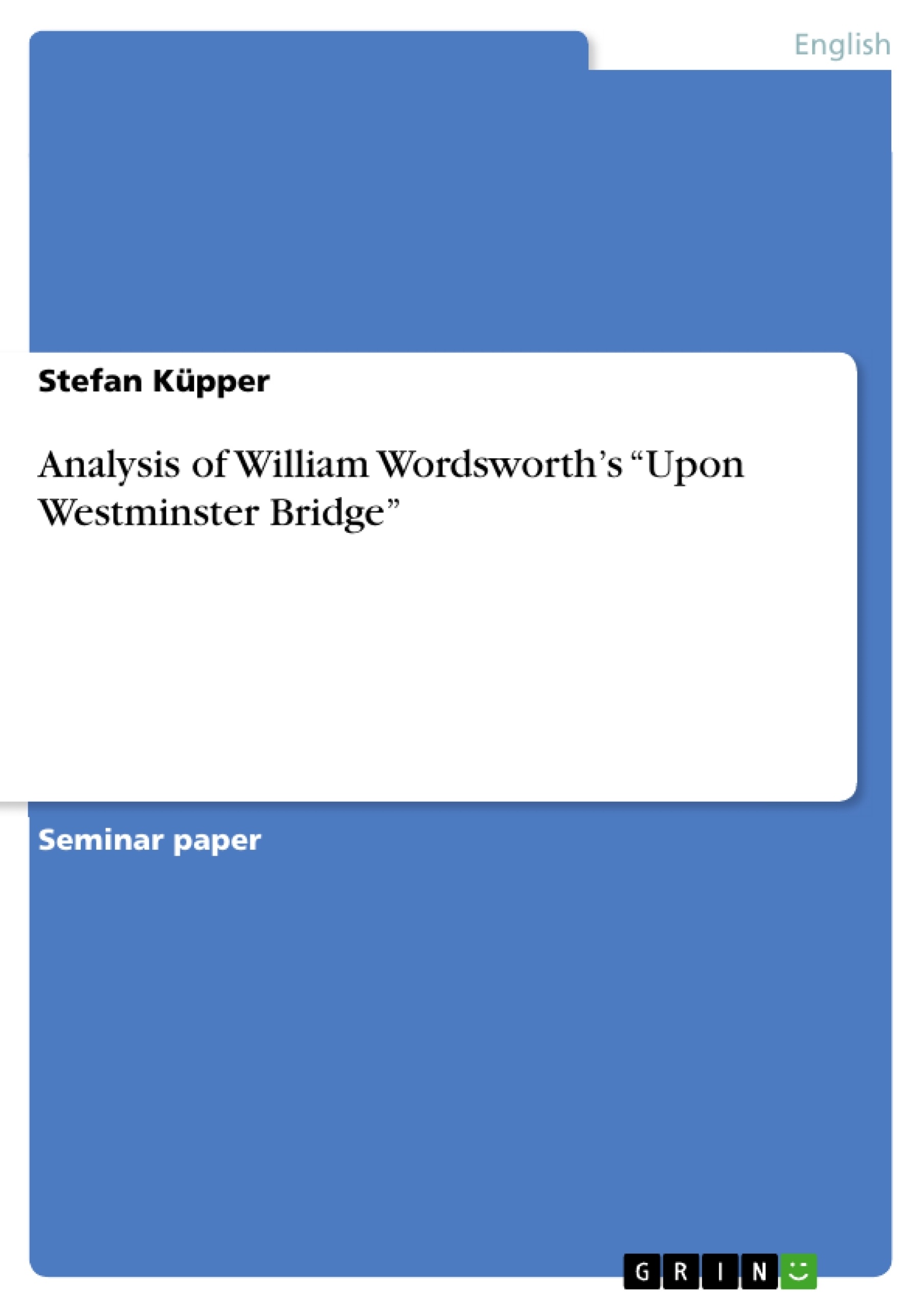When William Wordsworth wrote ‘Upon Westminster Bridge’ in September 1802, London was the economical as well as political centre of England. London set the tone for nearly everything – fashion, worn in London, was imitated in other provincial towns. The city became a metropolis – a place of consumption.
But on the other hand, London’s big-city appearance had some unwelcome side effects. According to industrial production the city was covered by fog nearly everyday. Streets and other public places were noisy and dirty and a terrible smell, like in Paris at that time, must have filled the air. Many people neglected their religious belief and some of them might even have lost their belief in God. Wordsworth probably wanted to make people aware that there is something more than the big-city life which is connected with hard work for the lower classes and a life of decadence which the upper classes enjoyed.
Table of Contents
- 1. Introduction
- 2. Analysis
- 3. Summary
Objectives and Key Themes
The objective of this analysis is to explore William Wordsworth's sonnet "Upon Westminster Bridge," examining its structure, imagery, and thematic concerns. The analysis aims to understand how Wordsworth presents the beauty of London in the early morning, contrasting it with the bustling city life and its potential negative impacts.
- The beauty of London's cityscape in the early morning.
- The contrast between the tranquility of the morning and the usual bustling city life.
- The sonnet's structure and its contribution to the overall effect.
- Wordsworth's reflection on the spiritual and emotional impact of the scene.
- The role of nature in Wordsworth's poetic vision.
Chapter Summaries
1. Introduction: This chapter provides biographical context for William Wordsworth and his sonnet "Upon Westminster Bridge," written in 1802. It establishes London's significance as a rapidly growing metropolis, highlighting the economic and political center of England at the time. The introduction contrasts the city's booming industrial production and its resulting pollution, noise, and overall hectic atmosphere with the potential spiritual neglect this environment could foster. Wordsworth's sonnet is presented as a response to this environment, an attempt to draw attention to a different perspective on the city and its relationship with nature.
2. Analysis: This chapter delves into a detailed analysis of the sonnet's structure and imagery. It explains the sonnet's form, its fourteen verses arranged into three quatrains and a couplet, and its rhyme scheme (abba abba cdcd ee). The analysis emphasizes the role of punctuation in slowing down the reading pace, encouraging a more attentive and appreciative engagement with the poem. The chapter then proceeds through each quatrain, exploring the imagery of the early morning cityscape, the personification of the scene's beauty, and the comparison of the city's morning tranquility to a garment that can be put on and taken off. The chapter also explores the contrast between the quiet morning and the bustling city, highlighting the descriptions of the calm river and the seemingly sleeping houses. The analysis culminates in the speaker’s apparent awe and contemplation of the unique tranquility and beauty of this moment.
Keywords
William Wordsworth, Upon Westminster Bridge, Sonnet, London, Romanticism, Cityscape, Nature, Tranquility, Contrast, Beauty, Industrialization, Pollution, Spiritual Reflection.
William Wordsworth's "Upon Westminster Bridge": A Comprehensive Language Preview - FAQ
What is this document?
This document provides a comprehensive preview of a language analysis focusing on William Wordsworth's sonnet "Upon Westminster Bridge." It includes a table of contents, objectives and key themes, chapter summaries, and keywords.
What are the main objectives of this analysis?
The analysis aims to explore Wordsworth's sonnet, examining its structure, imagery, and thematic concerns. It seeks to understand how Wordsworth portrays the beauty of early morning London, contrasting it with the city's bustling life and potential negative impacts. Specific themes explored include the beauty of the London cityscape, the contrast between morning tranquility and typical city life, the sonnet's structural impact, Wordsworth's reflection on the scene's spiritual and emotional impact, and the role of nature in his poetic vision.
What topics are covered in the chapters?
Chapter 1 (Introduction): Provides biographical context for Wordsworth and his sonnet, highlighting London's significance as a rapidly growing metropolis in 1802. It contrasts the city's industrial boom with its potential for spiritual neglect, positioning Wordsworth's sonnet as a response to this environment.
Chapter 2 (Analysis): Offers a detailed analysis of the sonnet's structure and imagery. It examines the sonnet's form, rhyme scheme, and punctuation, exploring the imagery of the early morning cityscape, personification, and the comparison of the city's morning tranquility to a garment. It also highlights the contrast between the quiet morning and the bustling city, culminating in the speaker's awe and contemplation.
Chapter 3 (Summary): This chapter is not explicitly detailed in the preview but would presumably summarize the findings of the analysis presented in Chapter 2.
What are the key themes of the analysis?
Key themes include the beauty of London's early morning cityscape, the contrast between tranquility and the bustling city life, the sonnet's structure and its contribution to the overall effect, Wordsworth's reflection on the spiritual and emotional impact of the scene, and the role of nature within Wordsworth's poetic vision.
What are the keywords associated with this analysis?
Keywords include: William Wordsworth, Upon Westminster Bridge, Sonnet, London, Romanticism, Cityscape, Nature, Tranquility, Contrast, Beauty, Industrialization, Pollution, Spiritual Reflection.
What is the intended audience for this document?
This preview is intended for academic use, supporting the structured and professional analysis of themes within Wordsworth's sonnet.
- Citation du texte
- Stefan Küpper (Auteur), 2005, Analysis of William Wordsworth’s “Upon Westminster Bridge”, Munich, GRIN Verlag, https://www.grin.com/document/146794



